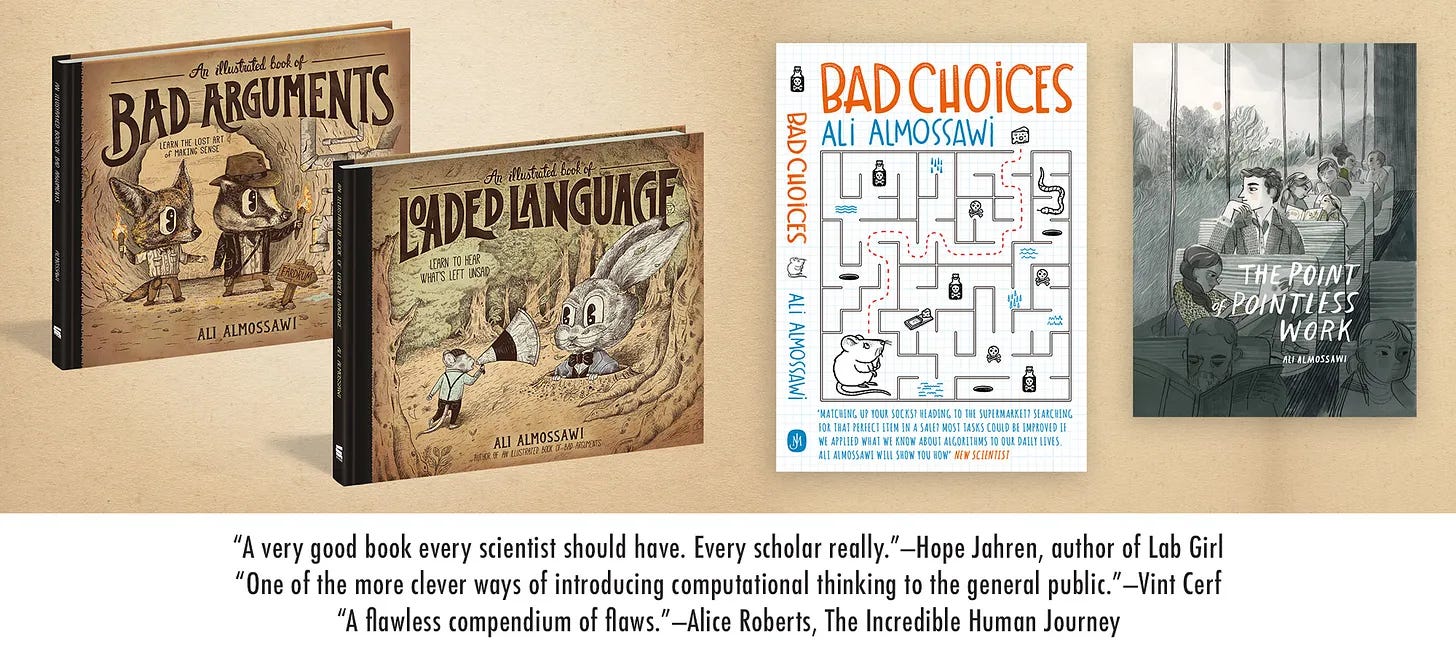Why We Think Only Others Get It Wrong
Plus, San Francisco’s little libraries, writers throwing shade, and the strangest cafe in town
Issue No. 42
For anyone with a significant other, the absolute best thing you can do right now is to forward this week’s issue to your significant other. I can’t imagine it being a bad idea, honestly. They’ll be appreciative of your thoughtfulness.1
You know how it goes, you hear someone state an opinion you disagree with, and you say to yourself, “How on earth can they be so blind to the truth?” Or you read someone’s opposing view to something dear to you and think, “It must be because they’re a hateful person.” In contrast, we consider our own views to be informed and objective.
A study looked into this blindspot.2 Participants were asked to assess how susceptible they thought they were to a set of eight cognitive and motivational biases. The biases included some that we’ve covered in past issues (e.g. the positive halo effect). Participants were then asked to assess how susceptible they thought the average American was to those same biases.
For all eight biases, participants rated themselves as less susceptible to them than the average American.
In a follow-on survey, a group of students were asked the same question, but were asked to compare themselves with the average student in their class. Here too, participants rated themselves as less susceptible than the average student in the class.

What’s behind this blindspot?
There are three forces that can keep us blissfully unaware of this blindspot.
The introspection illusion
The mistaken belief that our internal reasoning is a reliable, transparent window into all the factors shaping our judgments.
We don’t realize that not all of our impulses, gut reactions, biases, and habits can be inspected with the same ease. Many are subconscious. When we look inward, it might be possible for us to realize we were wrong about something in the past, maybe, but often not about the thing causing us to introspect right now.3 For instance,
You’re convinced you voted for a policy because of its merits. When asked why, you list its strengths. But later you learn a friend’s offhand comment, shared when you weren’t thinking about the vote, actually tipped the scales. Your introspective account omitted that influence entirely.
We notice the few thoughts that bubble up (e.g. “I considered both sides”) and ignore the many we never see (fear, insecurity, tribalism), then treat our limited view as complete.
Naive realism
We have a tendency to take our own perceptions as direct reflections of reality. If something feels obviously true, we conclude it must therefore be unbiased fact. When someone disagrees, we can’t fathom how they could have accessed the same clear reality, so we attribute their dissent to ignorance, irrationality, or hidden motives (“They just don’t get it” or “They must be anti-[this or that]”). This is the flip side of our own perceived clarity.
A good example of that is a line from comedian George Carlin:
Have you ever noticed that anybody driving slower than you is an idiot, and anyone going faster than you is a maniac?4
Fundamental attribution error
When you’re late to a meeting, you might blame traffic: “The road was terrible.” But when your partner is late, you might assume their character was the cause: “They just don’t care” or “They must think my time isn’t as important as theirs.”
Why? We have access to all the pressures and context that shape our own choices. So we explain them as situational. Observers see only the outcome of someone else’s choices and tend to jump to dispositional judgments (explaining their behavior by attributing it to their internal traits).
This mismatch in available information is the heart of the asymmetry: what feels like a clear, context-driven choice to the actor looks like a character-driven habit to the observer.
Countering the blindspot
In past issues where we’ve covered biases and fallacies, a takeaway I’ve often shared is to know the names and definitions of those biases and to keep them top of mind. The takeaway this time is that it’s not enough to recognize a bias, but that even with the best will, we simply might not spot it in ourselves as easily as we do in others.
One idea that has helped me over the years is to do role-reversal thought experiments. Imagine yourself as the person you disagree with on a topic, and have a debate with yourself in your head. What does that feel like? What internal thought patterns motivate your arguments? How do you try to rationalize things? I do it when I go for walks. It’s enlightening. And it doesn’t necessarily reveal you were wrong, but allows for the possibility the other person isn’t.
Another idea is to have people in our lives who disagree with us on issues, who can poke holes in our views and positions without it feeling antagonistic. Here, I mean people who genuinely disagree with us, but with whom we have enough of a shared history that the disagreement doesn’t impact our relationship with them. I’ve been fortunate to have such people in my life, and it makes a world of a difference in helping me know when I’m veering off the logical path.
Writers throwing shade at each other
A group of practitioners recently published a paper called,
The Illusion of Thinking
A critique of large language models’ ability to truly reason at scale. A few weeks later, another group responded with their own paper, critiquing that first one.
The Illusion of The Illusion of Thinking
Then the original group published a critique of the critique.
The Illusion of the Illusion of Illusion of Thinking
That got me thinking about other meta-titles, one in particular by Averroes that I read when I was very young. I’m sure there are others.
The Incoherence of the Incoherence
Which was a response to
The Incoherence of the Philosophers
Cataloging San Francisco’s little free libraries
I went around town taking pictures of all the little free libraries around San Francisco. You likely have them in your city too. They’re tiny libraries people setup in public places or in front of their homes where you can leave a book or borrow one.
A friend suggested auto-inventory these libraries. I used my little weekend trek around the city to test out an app I’ve been working on in my free time that lets you make any physical bookshelf searchable.
The platform is still in early access, and I’m chipping away at it as I find time.
Try it out and share your collections with me if you like. :)
Plus, check out the video on the website’s homepage; I used Veo 3 to generate the interviewer in that clip. (Let me know if you’d be interested in a full walkthrough of how I built this entire app.)

The strangest cafe
The strangest cafe opened downtown.
Not the least bit inconspicuous. No mist curling at its doors, no thunderclouds above, no rain drumming against its windows.
It sits across the street from a Whole Foods, by the on-ramp that connects the city to the peninsula.
Inside, the mood is cheerful. Festive, even. Faces glow gold under tungsten bulbs. Chairs screech against the ceramic floor as friends lean back in laughter. Students in hoodies, power cords in hand, snake between tables hunting for outlets. Delivery riders in shiny helmets swing open the door, stride to the register with purpose, and flash their phones.
The same familiar faces every day. The illustrator off in the corner. Headband, yoga pants, white socks, sketching with quiet focus. Bearded guy who’s permanently on a call with his co-founder. Something about user acquisition and product-market-fit. Curly-haired kid in yellow socks and open-toed sandals, always slipping outside to take his calls, pacing the sidewalk.
Two elderly men, clearly lifelong friends. The shorter one folds his cane after sitting down with the ease of habit, the taller one tosses the day's paper on the table. The barista brings them their black Americanos. "You can pay later."
The door jams a bit when you try to head out, but with a forceful push, you can get it to open.
I watch the people outside. I watch life pass. Any of us could leave whenever we wanted. Yet we always return.
I wonder how many people I’ve looked at all my life and never seen.
—John Steinbeck (The Winter of Our Discontent)
Until next time.
Be well,
Ali
P.S. Some past issues to read through in case you missed them.
I kid, of course. It’s inspired by a Bill Burr routine about his relationship with his wife who is “always working on [him]” for some reason. Here’s the clip (warning: language).
https://www.sakkyndig.com/psykologi/artvit/pronin2015.pdf
https://www.researchgate.net/publication/8458225_Objectivity_in_the_Eye_of_the_Beholder_Divergent_Perceptions_of_Bias_in_Self_Versus_Others
https://en.wikipedia.org/wiki/Na%C3%AFve_realism_%28psychology%29






